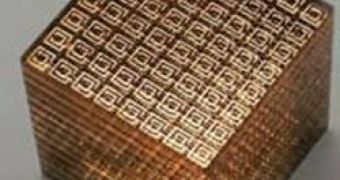Researchers studying the properties of metamaterials have found a way to lower the speed a beam of light is traveling at, by separating it in its constituent colors, creating some kind of a trapped rainbow. Light travels through space, at a speed of about 300,000 kilometers per second and is the maximum speed in the universe. To slow down a beam of light or even to stop it would probably revolutionize the way the information is stored and sent.
To overcome this challenge, Ortwin Hess of the University of Surrey, created a theoretical device that could stop light, by using metamaterials or materials whose properties depend mainly on their structure and not so much on the composition.
Usually, transparent materials such as glass and water have a positive refraction index, meaning that they barely slow down light, or re-orient the direction in which they travel, keeping light moving in the same direction. Metamaterials on the other hand have a "negative refractive index", meaning that they basically stop light in its track by reversing its direction.
The same materials have been used to create the "invisibility cloak" and the theoretical "electromagnetic wormhole" can be fabricated by creating intricate metal structures and arrangements in a transparent material, to bend light on itself and decrease its speed until it finally stops.
Though so far, the experiments regarding the research to create the "invisibility cloaks" have been only partially successful, due to the fact that the material only cloaks certain wavelengths in the microwave spectrum, Hess and his team describe the apparatus as 'a sandwich' between two normal materials, with the metamaterial wider on one end and narrower on the other, so the varying widths will compensate for all the different wavelengths of light in the visible spectrum and cause it to stop at certain points, creating in effect a rainbow of colors across the metamaterial.
However the device designed by Hess will not have the role to slow down the light. Certain experiments in this domain were made in the past, such as cooling atoms of sodium and rubidium at a temperature close to absolute zero, to slow and eventually stop the waves of light, basically trapping them in the atoms.
For now Hess' scheme can only remain theoretical, since technology is not advanced enough to create metamaterials small enough to be effective of the short wavelengths of the visible spectrum and research shows that actually the metamaterials have to be a bit smaller than the wavelengths of the used light.
Developing such metamaterials could trigger a revolution that will eventually replace the technique of sending data by using electrons, by sending photons instead, with the speed limitation suggested by Hess to allow more efficient means of processing information. Stopping light could also be useful, by creating storing memory devices, with incredible storing capacities.

 14 DAY TRIAL //
14 DAY TRIAL //